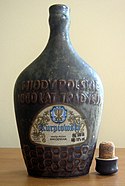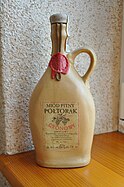Miód pitny

The miód pitny (literally translated "drinking honey") is a honey wine (mead) from Poland . It has been protected as a guaranteed traditional specialty in the EU since 2008.
Manufacturing
The miód pitny is made from honey and water, optionally flavored with natural additives such as vanilla. Depending on the ratio of honey to wine, it is known as Czwórniak (quarter), Trójniak (third), Dwójniak (half) and Półtorak (one and a half). The alcohol content is between 10% and 18%.
history
middle Ages
Already Ibrahim ibn Yaqub , the Poles traveled to 960, wrote that the country was rich in honey subjects of Mieszko I processed it to mead. Also Gallus Anonymus dismissed early 12th century out that Poland was rich in honey. Ambrogio Contarini mentioned Polish honey wine in the 15th century.
Early modern age
The Renaissance poet Sebastian Fabian Klonowic praised the honey wine, which he preferred to wine because the vine grows out of the dirty soil while the honey drips directly from Olympus. The oldest preserved recipe for making honey wine comes from the Swede Olaus Magnus , who received it from a Pole in Gniezno . With the decline of viticulture in Poland in the early modern period, the popularity of "drinking honey" increased. However, it was initially considered a luxury drink that was only reserved for the upper class. From the 16th century onwards, the four types mentioned above emerged. However, with the mass production of vodka in Poland in the 17th century, honey wine lost large market shares.
Modern
In the 19th century, the miód pitny was rarely produced. For this he was praised as an old Polish specialty in the literature of the Romantic era, for example in Pan Tadeusz with Adam Mickiewicz and Tomasz Zan and later in the trilogy by Henryk Sienkiewicz . For some time now, mead has been experiencing a renaissance in Poland. It has been protected by the EU as a guaranteed traditional specialty since 2008 .
See also
Web links
literature
- Besala, Jerzy (2015). Oholowe dzieje Polski: Czasy Piastów i Rzeczypospolitej szlacheckiej [Alcoholic History of Poland: Times of the House of Piast and the Noblemen's Commonwealth] (in Polish). Poznań: Zysk i S-ka Wydawnictwo. ISBN 978-83-7785-285-9 .



